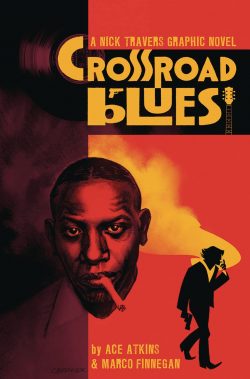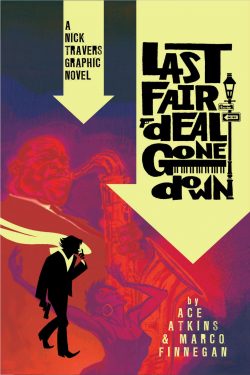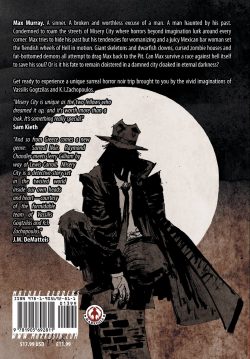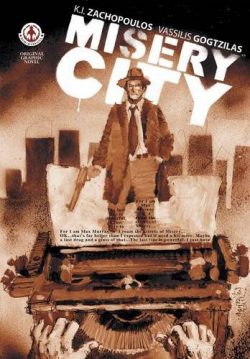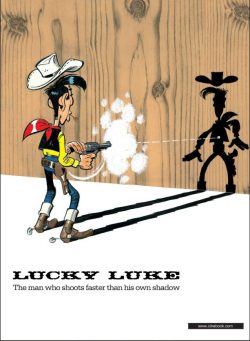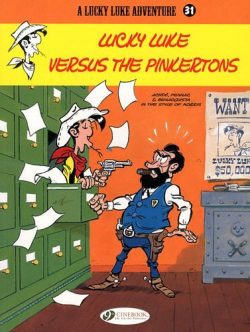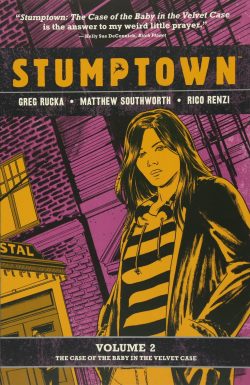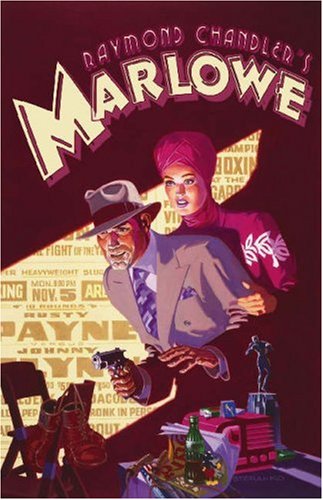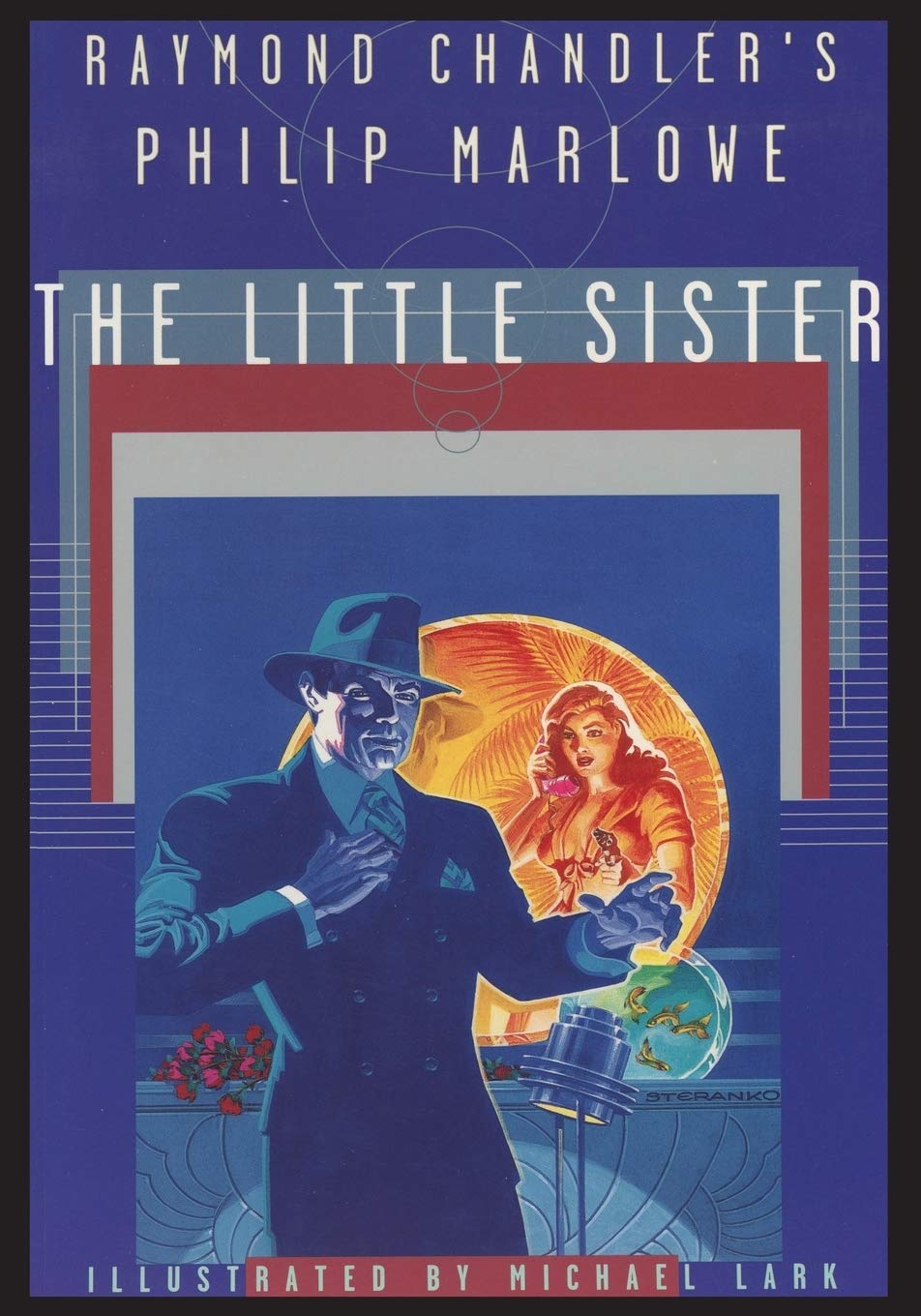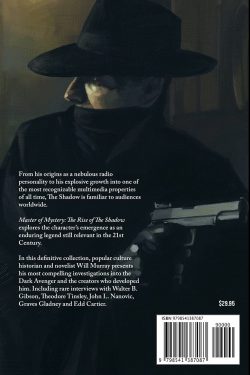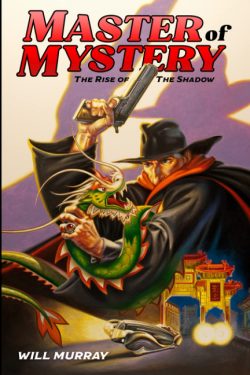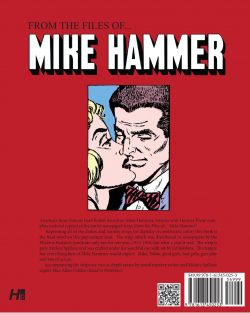
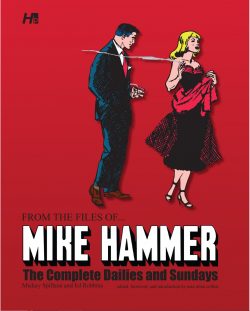
By Mickey Spillane & Ed Robbins: edited by Max Allan Collins (Hermes Press)
ISBN: 978-1-61345-025-3 (HB/Digital edition)
Frank Morrison Spillane was Brooklyn born on March 9th 1918 and raised in Elizabeth, New Jersey. He started writing in High School and, after trying a wide variety of jobs, joined a production shop in 1940, where he worked on articles for magazines (“slicks”), pulps and – thanks to a connection to Joe Gill (Captain Atom, Blue Beetle, Peacemaker and more horror, war and science fiction tales than you can imagine) – comic books.
Spillane wrote dozens of text fillers (usually the only place you could sign your own name) for Funnies Inc. who supplied Timely Comics, Fawcett, National/DC and more, but also crafted comics tales too, including Blue Bolt, Captain Marvel, Batman, Captain America and Sub-Mariner. A rough, tough guy, and already qualified pilot, he enlisted the day after Pearl Harbor, but his expertise denied him the combat he craved and relegated him to the despised role of Army Air Corps flight instructor, stationed in Mississippi.
Married in 1945, he found employment scarce when peace broke out and turned his 1942 comic creation Mike Lancer P.I. (latterly Mike Danger) into a rough, tough, vulgar and compelling paragon of toxic masculinity. The 1947 novel I, The Jury was written in 9 days and, on the suggestion of Ray Gill (brother of Joe), offered to EP Dutton. They published it in hardback which sold moderately that year. One year later the paperback edition sold six and a half million copies in the US alone, was translated everywhere, kicked off a detective boom in film and books, and created both an iconic character and arguably an entire subgenre. Spillane died in July 2006.
Love him or loathe (and people have always fallen pretty equally on either side) Mike Hammer changed the world of entertainment. Apparently based on Texas Ranger Mike Hamer (who killed Bonnie & Clyde in 1934), Hammer is hard-boiled and smart but also brutally violent, mercurial and misogynistic. His hatred for criminality borders on psychosis and in his later books viciously anti-communist. Despite respecting law and cops he considers both a constant impediment to justice. He carries a Colt 45 M1911A1 and has a distinctly modern relationship with his secretary Velda – who might well be a harder man than him. His best pal is NYPD Homicide Captain Pat Chambers…
Spillane wrote 13 Hammer novels between 1947 and 1996: a tiny fraction of a frankly heroic output, with the canon further extended in later years by crime maven and comics marvel Max Allen Collins – a close friend and associate who added 30 more to the tally. Working from Spillane’s notes, he posthumously extended Spillane’s Hammer canon by writing a further 13 Hammer novels and 17 other characters from the author’s notes…
Collins (Dick Tracy, Batman, Ms. Tree, Wild Dog, Mike Danger, Nathan Heller, Mallory, Nolan & Quarry series, The Road to Perdition) also edited and curated this epic collected archival edition, gathering another controversial Hammer spin-off but one of the anti-hero’s few failures…
We open with his Foreword ‘Mickey and Me’ and informative Introduction ‘From the Files of… Mike Hammer’ relating history and building context in heavily illustrated features sharing novel dustjackets, posters and lobby cards from some of the many movies, logos, designs and original art from the strip, all augmented throughout by promotional ads.
The short run was distributed by Phoenix Features Syndicate from 1953-1954: written by Spillane, Joe Gill and illustrator Ed Robbins, narrated like the books, in first person by Hammer. The reason for the minor league management was to keep authorial control out of the hands of timid censorious editors but it proved the strip’s undoing…
Originally compiled by Ken Pierce Books as Mickey Spillane’s Mike Hammer – The Comic Strip volume 1 (The Sudden Trap and Other Stories) & 2 (The Dark City and Other Stories), this edition maintains their layout of up to 4 dailies per page and opens with ‘Half-Blonde’ as the grim gumshoe stumbles over a pretty singer, witness – or culprit – to senseless murder. Inserting himself into the case, Hammer is shot, beaten and lied to but still unearths a long-buried secret to expose high society schemes of embezzlement and casual execution…
Whilst recovering from the latest bullet wounds incurred in the line of duty, Mike discovers dark deeds in the hospital and intercedes on behalf of ‘The Bandaged Woman’ who doesn’t officially exist; bringing down a diabolical doctor happy to butcher and torture patients to mollify his own monstrous child and maximise his personal fortune. Hammer’s cure is suitably efficient and comes in a single treatment…
The strip was full of raw, violence, barely concealed sex and comparatively shocking violence for America’s prime family entertainment medium, which made the subject of ‘The Child’ a charged one as Hammer is gulled by one gangster inro saving a little girl from another mob of kidnappers. When he learns he’s been made a patsy and the actual bereaved parent is President Eisenhower things get really nasty in the name of patriotism…
Hammer was never a conventional hero and the stories always pushed boundaries. Emotional turmoil rages through ‘Another Lonely Night’ after best pal Pat callously makes Mike bait to draw out mob killers and sits back as a procession of assassins seek to rub him out. At least the wounded warrior can always depend on pistol-packing Velda…
Newspapers used seasons as key sales points and everybody worked a ‘Christmas Story’ angle. For Hammer it took a typically bleak turn as – after arguing with Velda – Mike sets out to catch a crook on Christmas Eve: the busiest day of the year for grifters, grafters, pickpockets and buttonmen. Although apparently proving his point, Hammer had to ultimately concede that there is such a thing as the spirit of the season…
The dailies wrapped up with an epic ideological challenge as Hammer is targeted by the greatest criminal in America and forced to hunt an even worse public enemy in ‘Adam and Kane’. Facing three generations of sheer evil, Mike suffers a psychological freeze and is helpless against the truly diabolical son of aged Adam Shaver.
That “Napoleon of Crime” retired when he found true love but the fruit of it was even more evil and Adam now wants the toughest man in New York to bring him down for the sake of all.
Despite being physically outmatched and intellectually dwarfed, Hammer’s biggest handicap is his own fear until gloating Kane attacks other innocents under Mike’s protection. From then on, the gloves are off…
Sundays began on May 17th 1953 and there were only three before reader complaints ended the run and both strips. It began in full colour splendour with ‘Comes Murder!’ as Hammer discovers a young couple who have been gulled and roughed up by pro gambling racketeers. Incensed, Mike goes after slick Art Selton and meets his match and a major setback in the mobster’s busty blonde “assistant”. Overpowered but undaunted, he changes tack and quickly realises he’s not the only one after Selton. All he has to do is stir things up and stand back, but it helps if you know who’s actually calling the shots…
Crime never rests and when Hammer takes a short country break he meets a ghost in ‘The Sudden Trap.’ His astonishment at seeing the wife of gang boss Al Quinn two years after she died in a car crash and hubby dearest collected a million-dollar insurance pay out obsesses the PI, and his bullish investigations soon have everyone gunning for him. Luckily, local reporter Miss Hayes (no first name; just loads of diminishing “terms of affection”!) backstops him as he crashes from one wrong conclusion to the next until the many murderous fiends who want the revenant dead again are caught and the incredible truth is exposed…
The series concluded with ‘Dark City’ as traumatised Korean War vet Buddie and his sister Eve hire Mike to keep her safe from unknown assailants. Whilst doing the job, Hammer learns that he’s been lied to again. However, before he can confront them, the shamus is compelled by sheer decency to rescue her from abductors.
The scene of her being tortured is extremely graphic even by modern standards, leading to artist Robbins being accused of doing what no man could… killing Mike Hammer…
The story was wrapped up rapidly with our hero exposing the siblings’ scam in two-fisted style and the dream was over…
At its best the strip was evocative and extremely competent as well as being true to its times and its tenets. For those who admired Hammer’s oeuvre they comprise a lost treasure…
Closing this collection is behind-the-scenes feature ‘Restoring Mike Hammer’ by Daniel Herman revealing how the scattered and distressed remnants of the series were saved for publication.
Then come more objects of interest in ‘Mike Hammer and Pop Culture’ delivering poster and book cover art, extracts from comic spoofs ‘My Gun is the Jury! By Melvie Splane’ (Panic! #1 1954) and Mad Magazine’s parody of the 1980’s TV show (illustrated by Sam Viviano), candid photos and more.
Certainly not everybody’s shot of rye, From the Files of… Mike Hammer: The Complete Dailies and Sundays is a glimpse at a global icon at his visual peak: one you can take or leave but never ignore if you love exploring the annals of crime fiction.
© 2013 Mickey Spillane Publishing, LLC.


